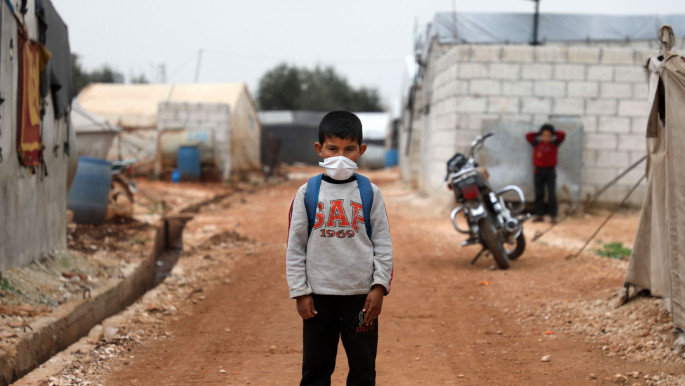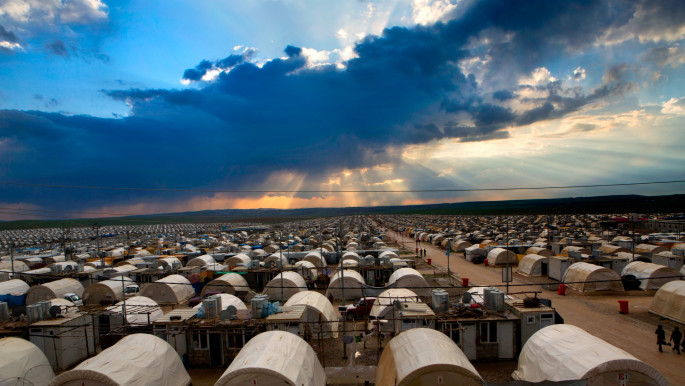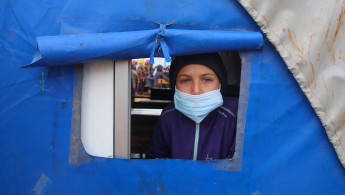Coronavirus could be a humanitarian catastrophe for Syria's Idlib
Meanwhile, those living in the opposition-held north face the same challenges, with the added threat of bombardment by the regime or their Russian and Iranian allies.
But Syria, like the rest of the world, is not exempt from the threat posed by Covid-19.
According to the regime-affiliated news agency SANA there have been 47 positive cases registered in regime-controlled areas of the country as of 11 May, 2020, with 29 people recovering and three deaths. In north-eastern Syria one fatality has been confirmed, with two further infections.
Although according to Samer Jabbor, the professor of public health at the American University of Beirut and co-chair of The Lancet Commission on Syria, "there is considerable speculation with regards to how many more cases there could be."
"Particularly in government-controlled areas, because of the late implementation of closures and the ineffectiveness of these distancing procedures," he told The New Arab.
 |
A coronavirus related catastrophe in north-west Syria could have just begun |  |
Further muddying the picture is the securitisation of the country, a main sticking point when it comes to accurately judging the number of cases. "Obviously health workers are reluctant to speak. And we are told, based on interviews, that patients are reluctant to express their symptoms. So, it's a challenge to figure out what the reality is," says Jabbor.
Fears are understandably high for regime-held areas, but concern is even greater in opposition-held north-west Syria. Dr Mahmood Hariri, the Director of the Health Information System Unit in north-west Syria, said that "in total 335 suspected cases have been tested conducted and all returned negative," although adds the caveat that the tests are only 75 percent accurate and it would be impossible to say with full confidence that there were no cases of coronavirus in north-west Syria.
 |
|
| Read more: 'Our fear is doubled': Exhausted by war, Syrians struggle to cope with coronavirus pandemic |
Dr. Hariri highlights a much larger problem. "We have a single testing machine, which is in Idlib city, that can perform 100 tests per day. And this lab has just 5,000 tests. We've used 335. These are all the tests we have. For over 4 million people. We were promised two other testing machines by the WHO, but until now, nothing."
A new report by the Health Information System Unit in north-west Syria has called for immediate action to prevent a serious outbreak in opposition held Idlib and Aleppo, and avoid a devastating loss of life. Dr Munzer al-Khalil, the head of Idlib Health Directorate is in charge of overseeing the health sector in an area where "there is a significant weakness as a result of the regular attack campaign that has targeted medical centres over the past year."
As seen in other countries around the world, hospital beds and access to ventilators are key to ensuring a reduced mortality rate and a high recovery rate. According to the report, as of April 2020 in north-west Syria, out of the area's 568 health facilities 306 remain functional, with 2,189 ward beds, 240 ICU beds, 98 adult ventilators and 64 paediatric ventilators.
According to Global Health Cluster, to meet minimal needs there should be at least 10 inpatient hospital beds per 10,000 people, with 10 percent of those being ICU beds, meaning that in northwest Syria, there should be 4,170, which represents a shortfall of almost 50 percent.
 |
Idlib is a part of the world where the population density is higher than almost anywhere else |  |
In their recent report the Health Information System Unit in north-west Syria have laid out three scenarios that the northwest region could face, based on WHO Covid-19 Essential Supplies Forecasting Tool, and data from the Health Information System Unit on population and health facility capacity and utilization in north-west Syria.
The first two scenarios are concerned with the population of 4.17 million as a whole, while scenario three applies only to the 1.2 million internally displaced persons (IDPs) in camps and tented settlements.
Read more: Syria Weekly: Greece's centre-right government moves towards Assad normalisation
The first scenario represents the more optimistic outlook with a "medium doubling rate" of every four days. According to the report, scenario one calculates 16,384 infections, representing 0.4 percent of the population. Of those infections 14 percent are expected to be severe and require admission to a hospital.
With this sort of admission rate and the capacity available, the health service would be overwhelmed eight weeks after the first recorded infection. Within the scenario, five percent of cases, 819 infections, are anticipated to be critical and require ICU beds. From the first recorded infection, the health system will be overwhelmed with severe cases by the beginning of week seven. With scenario one, the total number of expected Covid-19 deaths is 978.
 |
|
| Read more: Coronavirus highlights desperate plight of Syrian prisoners in Assad's jails |
Scenario two represents a less optimistic outlook for the region, although, study researchers consider it more likely for north-west Syria, "given the density of the population, chronic exposure to severe stressors, and the impracticality of implementing well-establishing measures of physical distancing and isolation."
Scenario two anticipates a fast doubling rate (every 3.2 days). The forecasted number of infections would jump drastically to 185,364, equating to 4.4 percent of the population. Of the total number of cases, 79.9 percent would be mild. Estimates suggest 27,804 people would require hospitalisation with severe symptoms, and six weeks after the first recorded case, the health system would be overwhelmed.
Read more: Is Assad now a liability? The mysterious Russian media campaign against Syria's dictator
For critical cases that require ICU support, of which there are expected to be 9,268, available capacity would be exceeded at the beginning of the sixth week after the first recorded case. With scenario two, the total number of expected Covid-19 deaths is 11,066.
By far, the most troubling projections come in scenario three, which models a situation of unmitigated spread in crowded displacement camps. Scenario three anticipates 20 percent of the population of 1.2 million, equalling 240,000, to be infected.
 |
'Flattening the curve' has become the mantra for Western countries. If north-west Syria is hit, that curve will quickly become an unavoidable mountain |  |
Of those cases, 35,000 would be classed as severe and require some form for hospital admission, a need that would surpass capacity five weeks after the first recorded case. Scenario three projections predict 12,000 cases will be critical and require ICU admission and capacity will be exceeded four weeks after the first recorded case. Four weeks after the first recorded case of coronavirus in the displacement camps, the death toll is predicted to reach 14,328.
According to Dr Aula Abbara, an infectious diseases research fellow and co-chair of the Syria Public Health Network, the population density of north-western Syria is a worrying factor, particularly in the IDP camps.
Speaking at a socially-distanced conference to mark the release of the report, Dr. Abbara said: "This is a part of the world where the population density is higher than almost anywhere else. There are 4.17 million in north-west Syria, with some of the areas with IDPs having a density of 40,000 per square kilometre."
Social distancing measures have been a vital tool in Western countries to prevent further spreading, measures that Dr. Abbara describes as meaningless and even laughable in an area with a population density like north-western Syria.
 |
|
| Read more: From genocide to pandemic: Yazidis in Iraq face looming mental health crisis as Covid-19 spreads |
'Flattening the curve' has become the mantra for Western countries. If north-west Syria is hit, that curve will quickly become an unavoidable mountain. The scenarios present an extremely worrisome future for the residents of north-western Syria, but according to the report's authors, these projections could represent a low end estimate for the regions.
In fact, for northwest Syria, the battle to ensure a successful recovery for those infected with Covid-19 could be over before it even starts. The devised scenarios assume that 50 percent of ICU beds could be available exclusively for coronavirus patients, but according to Dr Hariri, "between January 2019 to the end of the year the bed occupation rate for ICU beds was 98 percent. That means that we do not have a single bed available for an additional patient, during an average year."
As the reports states, "it will be simply impossible to manage the predicted critical cases expected during the first eight weeks, in all scenarios, resulting in significant excess mortality."
The north-western region of Syria is no stranger to death, but the threat of the coronavirus cannot be negotiated with, cannot be retreated from and is one which the region, with just 1.4 doctors for every 10,000 people, is desperately underprepared for.
As Dr Khalil puts it, a sense of fatalism has overcome the people of the region. "We ask people to stay home. They respond by saying 'We've died from chemical attacks. We've died from barrel bombs. We've died from a lack of food and water. Why should we respond to coronavirus. It's just one more reason for death in this area.'"
The scenarios put forward in the report measure the time until a total collapse of the health sector from the day of the first reported case. On the day that the report was published, reports of four positive coronavirus tests emerged from the city of Afrin.
A coronavirus related catastrophe in north-west Syria could have just begun.
Hugo Goodridge is a freelance journalist
Follow him on Twitter: @hugogoodridge



